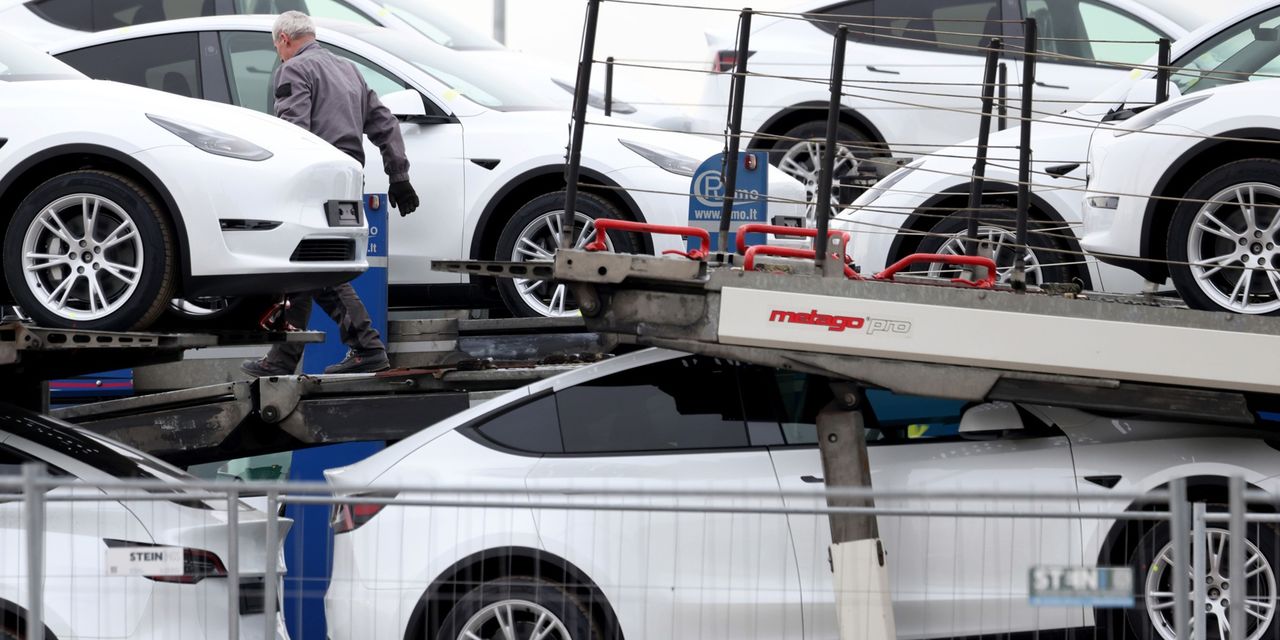The Tesla Model Y is the best selling battery electric vehicle in the world. It has a chance to be the best selling vehicle in the world, period, in 2023.
Liesa Johannssen/Bloomberg
The Biden administration will likely tighten emissions rules this coming week. For investors, that could mean more electric vehicles on roads sooner than expected.
There are endless EV numbers to track, and following multiple governments’ and companies’ goals is no easy task. Investors will have to try, however, if they hope to pick automotive winners and losers in coming years—and there are a few potential standouts already.
Environmental Protection Agency officials are set to reveal new pollution standards on Wednesday in Detroit, The New York Times reported on Saturday . The practical impact of the standards would mean that two-thirds of all new passenger vehicles in the U.S. would be all-electric by 2032.
The EPA didn’t immediately respond to Barron’s request for comment about the report.
It can feel like different governments’ and companies’ goals never match up with another. There’s also the problem of comparing apples to oranges: Many EV goals, including the EPA’s, include plug-in hybrid vehicles, or PHEVs, and all-battery electric vehicles, or BEVs.
Take
Toyota Motor
(ticker: TM): In 2021, the company wanted to sell about 3.5 million BEVs by the end of the decade. That would amount to roughly 35% penetration of Toyota new car sales. On Friday, Toyota updated its goals: It now wants to sell 1.5 million BEVs annually by 2026. That would be about 15% penetration of its car sales by 2026.
While Toyota sold less than 30,000 all-electric vehicles in 2022, the Japanese auto maker sold roughly 2.7 million “electrified” vehicles that year. About 2.6 million of those were hybrids and PHEVs.
See Also: Tesla Cuts Prices in the U.S. Again. The Timing’s Down to EV Tax-Credit Changes.
Being dominant in hybrids is fine, but BEVs are gaining more market share versus PHEVs as batteries get cheaper and charging times improve. Several years ago, adding some batteries and a small electric motor to a conventional vehicle increased costs slightly while improving mileage. Now, vehicles with traditional engines and batteries can be more expensive to maintain and purchase than BEVs.
BEV sales accounted for roughly 75% of all plug-in vehicles in 2022. In 2015, a couple of years before
Tesla
(TSLA) launched its BEV Model 3, PHEVs represented about half of all plug-in vehicle sales.
Toyota is lagging behind the competition—and U.S. auto makers are fine with that.
Ford Motor
(F) plans to be sell BEVs at a “run-rate” of 2 million units a year by the end of 2026, which would require constantly increasing sales. Ford’s goals imply that by 2027, about 50% of its global sales should be all-electric.
General Motors
(GM), meanwhile, is hoping to sell 1 million EVs a year in North America by 2025, or roughly 33% of all of its new North American vehicle sales. GM wants to be an all-electric seller around the world by 2035, too.
GM doesn’t have a European business anymore. The bulk of its vehicles are sold in the U.S. and China.
In the U.S., about 810,000, or 6%, of all passenger vehicle sales were battery-electric in 2022, up about 66% year over year. New, stricter EPA standards could help drive that number higher and faster.
Don’t forget California: It’s more aggressive than the EPA. The Golden State wants to have about 68% of all new passenger vehicles sold in the state to be either all-electric, fuel cell-powered, or plug-in hybrid vehicles by 2030. By 2032, when the EPA wants 67% EV penetration, according to the Times report, California is aiming for 82%.
These numbers may seem lofty, but the rest of the world is ahead of the U.S. In Western Europe, BEVs made up roughly 1.6 million units—or 13% to 14%—of all new vehicle sales in 2022, up about 33% compared with 2021.
Meanwhile, about 4.4 million BEVs were sold in China in 2022, up about 85% year over year, accounting for roughly 22% of all new vehicle sales. Citi analyst Jeff Chung predicts that roughly 6 million BEVs will be sold in China sold in 2023, or 30% of all new vehicle sales in the country.
Putting it together, investors should expect EVs to comprise as much as 50% of all new vehicle sales by 2030. That works out to roughly 40 million to 45 million BEVs a year by the end of the decade—and up from the roughly 8 million sold around the globe in 2022.
That’s a lot of growth. And companies that don’t plan to match that mix, or have the capacity and models to match that mix, risk losing market share. GM and Ford plan to meet those targets.
Then there is Tesla: It only sells BEVs. Wall Street expects it to sell about 1.8 million BEVs in and 3.5 million in 2026. Faster penetration of EV sales means less pressure on Tesla’s market share of EV sales. The total addressable market increases as EV sales expand–and that’s good for Tesla shares, too.
Tesla’s market share of EV sales in the U.S. ended at about 65% in 2022. Globally, Tesla captured about 17% of total BEV sales.
Write to Al Root at [email protected]
Read the full article here










